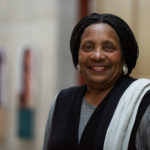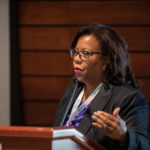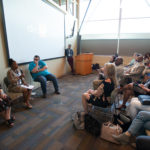View Larger Image

The morning session featured Valerie Yerger, M.A., N.D.
Community Partners Gather to Address Health Disparities
| The role of partnerships in research was emphasized April 26 at the Community Campus Partnership Conference to address health disparities held at Heifer International in Little Rock.
The conference, presented by UAMS, brought together over 200 community leaders, students, educators, social workers, health care workers, researchers and stakeholders to discuss strategies that enhance the development and sustainability of community-campus partnerships in Arkansas.
“This is an opportunity for us, as researchers, not only to discuss health disparities with community organizations, but also to identify opportunities for new projects and partnerships,” said Keneshia Bryant-Moore, Ph.D, RN, associate professor in the UAMS College of Public Health’s Health Behavior and Health Education Department and conference planning committee chairperson.
Attendees utilize the conference to discuss health disparities and identify ways that community partners and researchers can work together on projects to reduce them.
Keynote speaker Ella Greene-Moton, community education coordinator at the Center for Public Health and Community Genomics at the
University of Michigan School of Public Health, discussed what is known about community-campus partnerships.
“We know that without community input, much of what we do would not be possible,” Moton said. “There needs to be bidirectional learning, transparency and respect between community members and researchers.”
Moton has an extensive background in public health advocacy, public health policy, community-based participatory research and programming, spanning over 40 years in Flint, Mich. She shared insights from her years of experience working with community partners.
“As far as community-campus partnerships, they are the best thing since sliced bread,” Moton said. “We must train ourselves to be the best agents for community, for partnership and for making ourselves better.”
The morning session featured Valerie Yerger, M.A., N.D., associate professor of Health Policy in the Department of Social and Behavioral Sciences and in the Center for Tobacco Control Research and Education at the University of California, San Francisco.
Yerger was an original researcher of the tobacco industry documents and has years of experience analyzing tobacco documents. She discussed her work in examining the tobacco industry’s relationships with African American leadership groups and the tobacco companies’ marketing of menthol cigarettes in inner-city communities.
The afternoon session featured Martha Phillips, Ph.D., M.P.H., MBA, associate professor of epidemiology in the UAMS Fay W. Boozman College of Public Health.
Phillips has been extensively involved in health promotion within Arkansas, with a primary emphasis on the health of children, minority residents and rural communities. She discussed preliminary findings of a research project from the Arkansas Prevention Research Center to reduce hypertension in the Delta: Take Control: A Stepped Care Approach to Hypertension Control.
Breakout sessions throughout the day included topics on homelessness, hunger and health; opioids, incarceration and healthcare; the Arkansas Center for Health Disparities; mental health and faith communities; health disparities; and community research training. There were also over 15 exhibitors from organizations around the state.
The conference was partially funded by the Arkansas Center for Health Disparities, the Arkansas Prevention Research, and the UAMS Center for the Study of Tobacco. Other collaborators were the UAMS Translational Research Institute, the UAMS Fay W. Boozman College of Public Health, and the Arkansas FAITH Network.



